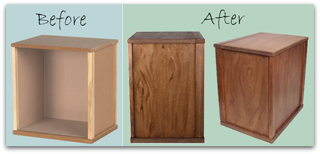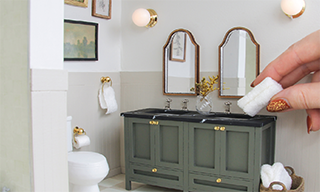
Snap knife
Although a conventional craft knife is always within reach, my favorite knife for almost every use is a snap knife, so-called because the blade is segmented and a dull area can be snapped off to expose a sharp new blade. It can be operated with one hand, has a ratcheting mechanism to retract or advance the replaceable blade as much as needed – great for thick foam core and builders foam – and a lock to hold it in place, open or closed. For safety, there is a slotted key to hold the blade as you snap for a fresh one. Inexpensive, readily available (hardware stores), safe to carry and always sharp – what’s not to love?

Handy Measuring Tools
As you shop for minis – or things that could become minis – it’s good to know what size something is and what that size would be in a real-life item. But you don’t have to pull out a tape measure – you can be your own ruler! For example, my hand, from the base of my palm to the tip of my middle finger, is about 6"; the width across my palm is 3" and my thumb is 2½" long from tip to knuckle. So I instantly know that any doll (especially female) taller than my palm is too tall for 1/12 scale and that any table height different than the length of my thumb is not conventional dining height (30").
On the other side, my forearm, from the inside of my elbow to the base of my index finger, measures 12", so a 1" long miniature would be the size of my forearm in real life – would that really be accurate for a miniature whatever?
My favorite mini measure is my little fingernail, which is just about the size of a doll’s hand. If a hand the size of my fingernail couldn’t grasp the mini, the mini is out of scale.
So pull out a ruler and take your own handy measurements; they’ll be with you wherever you go.

Shoe polish as stain
One of my favorite easy solutions to potentially messy projects is using liquid shoe polish as a stain for floors and other unfinished wood items. It has its own applicator, goes on easily, dries quickly, is virtually odorless, and can be buffed with a paper towel to a nice sheen. Wood flooring sheets will curl slightly while the polish is wet but will flatten when it dries. It does not cause the strips to loosen from the paper backing, so it’s fine (and easier) to finish the sheets before installation. Color choice is limited, but Kiwi Color Shine Brown is a good medium-dark that works with almost everything. Kiwi Scuff Cover White gives a nice pickled finish I have used on ceilings. For just the sheen of a wax finish – or more than the polish has by itself – Kiwi Express Neutral (colorless) is another easy option. (More coats plus buffing adds shine, even if they say you don’t need to.)

Shoe Polish, Part 2: Make MDF look like finished wood
The new QuickBuild Display Boxes from Houseworks gave me a chance to try something new with my favorite Kiwi liquid shoe polish — and it worked! I needed a quick exterior finish that wasn’t painted, so before assembly, I gave the entire box a quick sanding, then one overall coat of polish. Next, without really waiting for the first application to dry, I used the polish applicator to “draw” a woodgrain pattern on the surface, working the wet polish into lighter and darker streaks and curves, with the occasional knot for interest. After it dried, I brushed on a couple of coats of gloss varnish. I didn’t do any further sanding, but a bit of smoothing and another coat of varnish would improve the final look even more.
This could be a great quick way to create wood-look floors on MDF, for example. You could do the entire surface, as I did, and use a pencil or marker to indicate plank lines afterward, or mask off alternate “boards” with strips of masking tape and do the process in a couple of steps.

Wood “fringe”
The next time you have little fringes of wood to clean up after a saw cut, don’t reach for the sander to get rid of them. Instead, try small, sharp scissors – with a curved blade if possible – to cut the fringe cleanly away. Cut carefully, and you’re less likely to affect the contour of the wood than with sanding.



